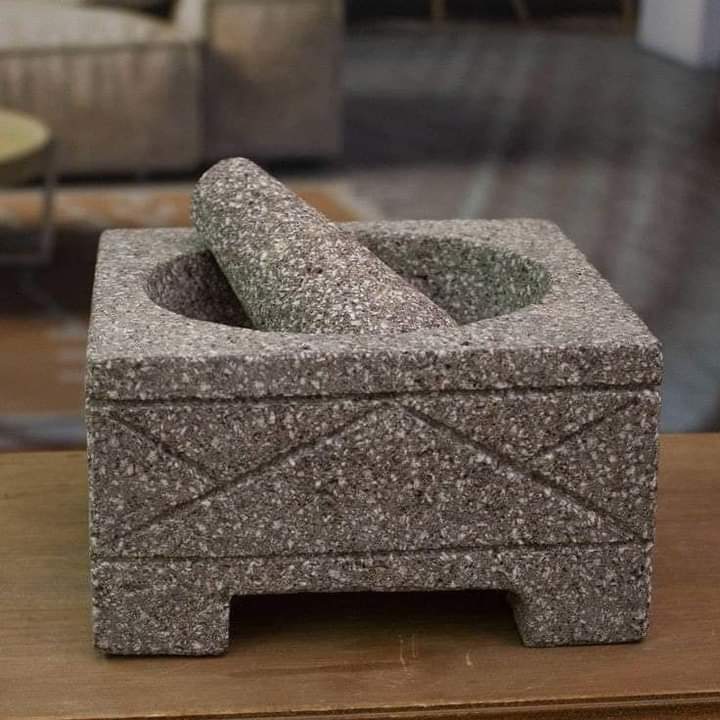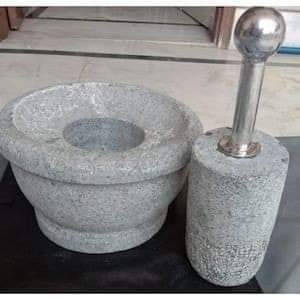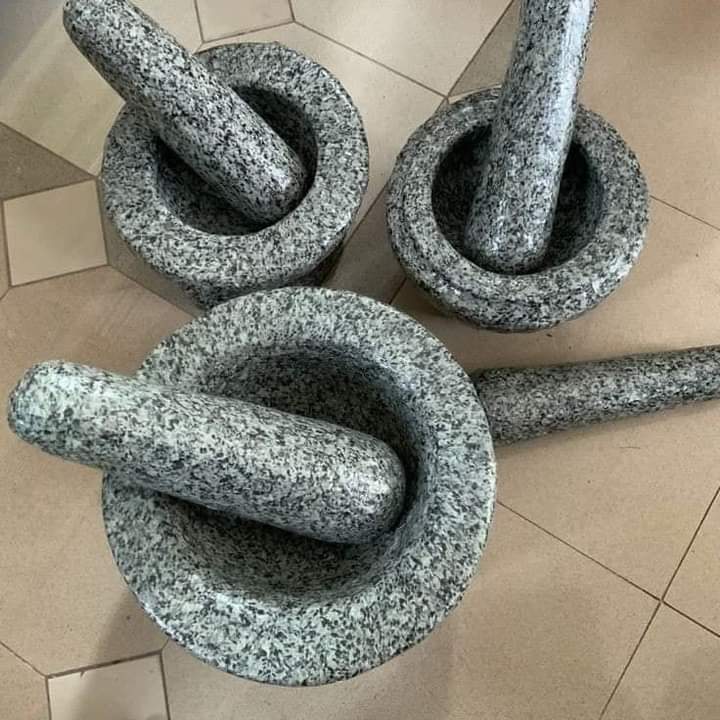Origins And Early Use:
The use of mortar and pestle in Africa dates back to ancient times, as early as the Neolithic period (around 10,000 BC), when early African societies began cultivating crops like millet, sorghum, and yam.Archaeological excavations in regions such as the Sahel and Nubia have uncovered grinding stones and early mortars, suggesting their use in processing grains.
Cardinal Use
Processing Staple.
The mortar and pestle are widely used across Africa for pounding grains (e.g., millet, sorghum, maize) into flour for porridge, bread, and other staples.In West Africa, it is central to making fufu, tuo zaafi, and other starchy dishes. Cassava, yam, or plantains are pounded into a smooth, stretchy consistency.In East and Southern Africa, it is used to grind maize for ugali or millet for traditional porridge.
Spices And Pastes:
Herbs and spices like chili, ginger, and garlic are crushed into pastes for sauces, soups, and stews.Mortars and pestles preserve the authentic flavors and textures of these ingredients, integral to African cuisine.
Cultural And Social Significance:
Rituals and Celebrations: Mortar and pestle are often used during communal events and celebrations, symbolizing unity and collaboration as women work together to pound food.
Symbol of Tradition: In many African communities, the mortar and pestle are passed down through generations as cherished household items.
Songs and Rhythms: In some West African traditions, the rhythmic pounding of the mortar and pestle is accompanied by singing, creating a communal and celebratory atmosphere.
Materials And Craftsmanship:
Mortars and pestles in Africa are often handcrafted from durable materials like wood (e.g., mahogany, ebony), stone, or clay, depending on the region. The craftsmanship reflects local artistic styles and functionality.
Modern Day:
While modern appliances are becoming more common, the mortar and pestle remain widely used in rural areas for their practicality, cultural significance, and ability to preserve the authentic taste of traditional dishes.They are also iconic symbols of African culinary heritage, often displayed in homes and cultural exhibitions.The mortar and pestle's enduring presence in Africa highlights its importance not just as a kitchen tool but as a vessel of cultural identity and tradition.
This tool is a mortar and pestle  made of solid stone, specifically designed for grinding, crushing, and mixing spices, herbs, and seasonings.The mortar is the bowl that holds the ingredients.The pestle is the club-shaped tool used to crush or grind the ingredients within the mortar.Stone mortars and pestles are highly durable and ideal for creating pastes, powders, or blends with natural textures. They are commonly used in traditional and modern cooking for making spice mixes, herbal remedies, and sauces like pesto or guacamole. The solid stone material ensures efficient grinding and retains the authentic flavors of the ingredients.Solid stone mortar and pestle is a traditional kitchen tool used for grinding, crushing, and mixing ingredients like spices, herbs, and seasonings. It is made from durable stone, such as granite or marble, which provides a hard, non-porous surface ideal for grinding.
made of solid stone, specifically designed for grinding, crushing, and mixing spices, herbs, and seasonings.The mortar is the bowl that holds the ingredients.The pestle is the club-shaped tool used to crush or grind the ingredients within the mortar.Stone mortars and pestles are highly durable and ideal for creating pastes, powders, or blends with natural textures. They are commonly used in traditional and modern cooking for making spice mixes, herbal remedies, and sauces like pesto or guacamole. The solid stone material ensures efficient grinding and retains the authentic flavors of the ingredients.Solid stone mortar and pestle is a traditional kitchen tool used for grinding, crushing, and mixing ingredients like spices, herbs, and seasonings. It is made from durable stone, such as granite or marble, which provides a hard, non-porous surface ideal for grinding.
 made of solid stone, specifically designed for grinding, crushing, and mixing spices, herbs, and seasonings.The mortar is the bowl that holds the ingredients.The pestle is the club-shaped tool used to crush or grind the ingredients within the mortar.Stone mortars and pestles are highly durable and ideal for creating pastes, powders, or blends with natural textures. They are commonly used in traditional and modern cooking for making spice mixes, herbal remedies, and sauces like pesto or guacamole. The solid stone material ensures efficient grinding and retains the authentic flavors of the ingredients.Solid stone mortar and pestle is a traditional kitchen tool used for grinding, crushing, and mixing ingredients like spices, herbs, and seasonings. It is made from durable stone, such as granite or marble, which provides a hard, non-porous surface ideal for grinding.
made of solid stone, specifically designed for grinding, crushing, and mixing spices, herbs, and seasonings.The mortar is the bowl that holds the ingredients.The pestle is the club-shaped tool used to crush or grind the ingredients within the mortar.Stone mortars and pestles are highly durable and ideal for creating pastes, powders, or blends with natural textures. They are commonly used in traditional and modern cooking for making spice mixes, herbal remedies, and sauces like pesto or guacamole. The solid stone material ensures efficient grinding and retains the authentic flavors of the ingredients.Solid stone mortar and pestle is a traditional kitchen tool used for grinding, crushing, and mixing ingredients like spices, herbs, and seasonings. It is made from durable stone, such as granite or marble, which provides a hard, non-porous surface ideal for grinding. Mortar (bowl):
Depth:
A deeper bowl ensures that the ingredients stay inside the mortar, even when crushed or ground with force.It reduces the risk of ingredients bouncing out during the process.
Weight:
The heavy stone material keeps the mortar stable on the surface, preventing it from tipping or sliding while grinding.This stability is particularly important when applying pressure with the pestle.
These features make it an excellent tool for safely and efficiently grinding even large or tough ingredients.Designed to hold the ingredients securely while grinding.
Pestle (grinder)
A pestle is the handheld, club-shaped tool used in conjunction with a mortar for grinding, crushing, and mixing various ingredients. It is typically made from the same durable material as the mortar, such as stone, wood, ceramic, or metal.A rounded, club-shaped tool used to crush and grind ingredients against the mortar's surface.
Designed for effective grinding and crushing of ingredients against the mortar's surface.
Provides even pressure to create fine powders or pastes.
2. Handle:
Eonomically designed for a comfortable grip.
Allows for easy application of force during grinding.
Uses:
Grinding spices like peppercorns, cumin, or cloves.
Grinding herbs for pastes or marinades
Crushing herbs for culinary or medicinal purposes.
Crushing spices like peppercorns, cloves, or cinnamon.
Blending wet ingredients into pastes (e.g., garlic, ginger, or chili).
Preparing traditional dishes such as guacamole, pesto, or curry pastes
Preparing traditional dishes such as guacamole, pesto, or curry pastes.
Benefits:
Retains natural flavors and aromas.
Durable and long-lasting.
Easy to clean and maintain with proper care.
Simple yet highly effective for manual grinding.
Retains the texture and flavors of ingredients, unlike mechanical grinders.
A pestle complements the mortar, making it a versatile and essential tool for both traditional and modern cooking.
This tool is a staple in both traditional and modern kitchens worldwide.
The mortar and pestle also plays a significant role in promoting health in African cultures, both through its use in food preparation and its historical and traditional medicinal practices.
Health Benefits in Culinary Use:
Retains Nutritional Value:
Grinding with a mortar and pestle preserves the natural properties of ingredients. Unlike modern blenders or food processors, which can heat up the ingredients, the manual grinding process retains the flavor, nutrients, and essential oils of spices, herbs, and grains.
Gentle Grinding:
The manual grinding process, as opposed to electric grinding, ensures that ingredients are broken down without losing their vital nutrients. For instance, grinding grains like millet or sorghum helps to retain fiber and other essential nutrients.
Enhancing Digestion:
Some traditional African health practices involve grinding herbs and spices (such as ginger, garlic, or turmeric) with a mortar and pestle for medicinal purposes. These ingredients are often used to aid in digestion, boost immunity, and address common ailments.Ground spices like ginger and turmeric are known for their anti-inflammatory and digestive health benefits, making their use in traditional remedies beneficial to overall health.
Antioxidant Properties:
Spices like garlic, pepper, and cloves, when ground using a mortar and pestle, release more antioxidants compared to pre-ground versions, helping in boosting immunity and fighting off free radicals that may cause diseases.
Health Benefits in Traditional Medicine:
Herbal Remedies:
In traditional African medicine, the mortar and pestle are used for preparing various herbal concoctions and pastes that are used to treat a range of ailments. These might include using crushed leaves, roots, or bark to treat conditions such as fever, headaches, and digestive issues.For example, crushed baobab leaves might be used for their high vitamin C content to boost immunity, while moringa is used in traditional medicine for its anti-inflammatory and antioxidant properties.
Topical Applications:
Pastes made from herbs and plants like aloe vera, turmeric, and neem are often ground in a mortar and pestle and applied topically to treat skin conditions such as wounds, rashes, and infections. The grinding process helps release active compounds that are absorbed by the skin more effectively.
Healing Rituals:
In some cultures, the use of the mortar and pestle in healing rituals is important. It is believed that the rhythmic pounding motion of the pestle can help release healing energies from the ingredients and aid in spiritual as well as physical health.
Mind-Body Connection:
Physical Activity: The act of manually grinding with a mortar and pestle provides moderate physical exercise, engaging the arms and shoulders, and can be a form of physical activity in areas where other forms of exercise are less accessible.
Mindful Cooking: Using a mortar and pestle can be a meditative experience, encouraging mindfulness during food preparation. The slow, deliberate grinding process can reduce stress and increase focus, contributing to overall mental well-being.
The mortar and pestle's role in African cooking and traditional medicine is not just about preserving culture and taste, but also about supporting health and well-being. Whether it’s enhancing the nutritional value of food, creating powerful herbal remedies, or fostering a mindful approach to cooking, the mortar and pestle remains an important health tool in African societies.












